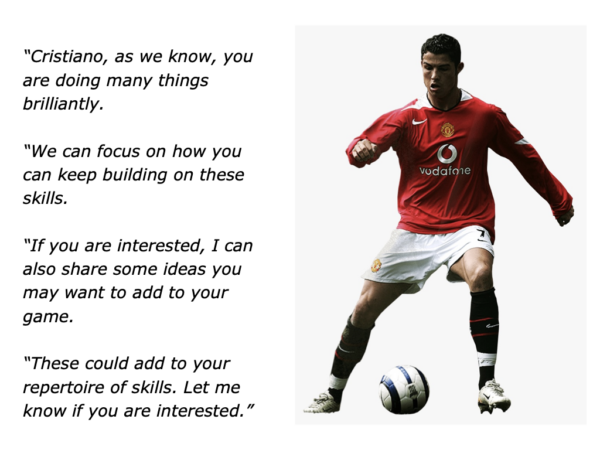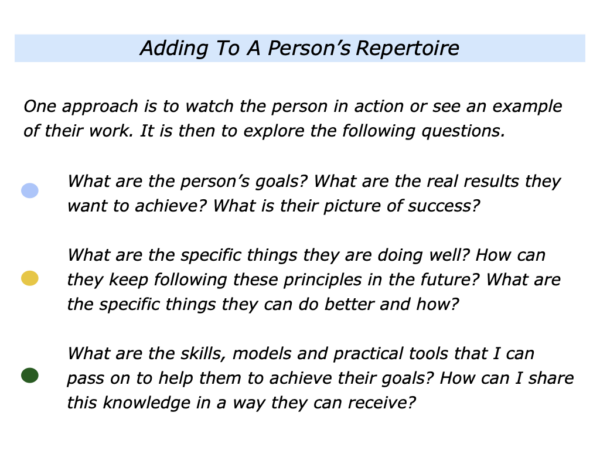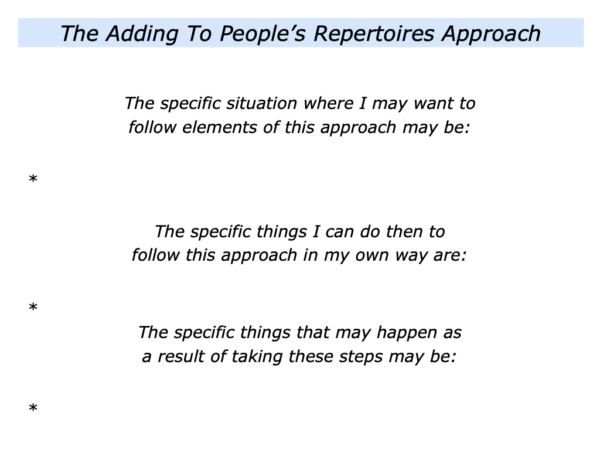
There are many ways to help people to develop. One approach is to build on their resources and help them to add to their repertoires for achieving the desired results.
This approach can be more effective then telling a person they have to change. It is an adding approach rather than a subtracting approach. Let’s explore how it can work in action.
Results
Imagine that a person has asked you to help them to develop. The first step will be to create a positive environment in which they feel able to explore.
You can then invite the person to describe the specific activities in which they would like to develop. They may say, for example, that they would like to be better at being able:
To focus on their priorities … To stay calm in certain situations … To build on their strengths … To lead a team … To improve their skills in a certain activity … To do satisfying work that also earns a good salary … Or other topics.
Imagine the person has describe several activities in which they want to develop. The next step is to invite them to choose which of these they would like to focus on first. You can then invite them:
To clarify a specific situation where they want to do this activity – this could be a personal or professional situation;
To clarify the real results they want to achieve in the specific situation;
To clarify the benefits of achieving these results in the specific situation.
Imagine that the person is clear on the results they want to a specific situation. You can then move on to the next step.
Resources
This step involves focusing on the resources a person already has that they use to achieve their goals. One approach is to explore the following themes.
What are the person’s strengths? What is their successful style of working? What are their assets? What are the personal and professional resources they have? How can they use these to help them to achieve their goals?
Imagine that you have explored these themes with the person. You have helped them: a) to clarify their resources; b) to clarify how they can use some of these to work towards achieving the desired results.
The person can build on their resources but there may be skills they can add that will help them achieve success. This leads to the next theme.
Repertoire
This step involves focusing on what the person can add to their repertoire to achieve their goals. For example, you may be able to offer them certain strategies, skills and practical tools. The key is to position these in a way the person can accept and use.
Let’s look at one example of translating this approach into action. A newly arrived football coach was about to run his first session with the players at Manchester United. One session was with the young and often brilliant Cristiano Ronaldo. The coach asked himself:
“How do you help Ronaldo to develop? There are parts of his game he can improve, but how to encourage him to be open and listen?”
Bearing this in mind, he prepared what he would say on their first meeting. This was long the following lines.

The approach worked. Ronaldo said he wanted to add to his skills and be even more successful.
Imagine that you are helping a person to work towards achieving their goals. How can help them to add to their repertoire? How can you position what you offer in a way the person can accept and use?
There are many ways to add to a person’s repertoire. One approach is to watch them in action or see an example of their work. It is to then ask yourself some of the questions described below.

You can aim to pass on the knowledge in a way they can receive. Before doing so, however, it can be important to ask the person:
“Is it okay for me to share some ideas you may be able to use to achieve your goals?”
The person will say ‘Yes,’ but it can be good to get their psychological permission. You can then pass on the knowledge in a way that resonates with them. How to tell if this is happening?
One approach is to watch their body language to see which ideas may resonate. Alternatively, and particularly with people who are introvert, you may simply want to create a break and ask the person:
“Looking at these ideas, are there any that resonate with you? If so, we can explore these in more depth.”
Imagine the person has focused on how they can build on their resources to achieve their aims. They may also have taken on board some of the ideas you have shared. It is then time to move on to the next step.
Results
Bearing in mind the results the person wants to achieve, they can make an action plan they believe in. If appropriate, however, you can invite them to focus on the following themes.
“What are the key strategies you can follow to give yourself the greatest chance of success? How can you translate these into action? How can you get some quick successes?
“How can you follow good habits? How can you manage any challenges? How can you build on what is working? How can you tackle areas for improvement? How can you do everything possible to reach your goals?”
The person can then move into action. If appropriate, you can continue to help them on the journey. You can keep helping them to add to their repertoire on the way towards achieving the desired results.
Looking ahead, can you think of a situation where you may want to follow elements of the adding to people’s repertoire approach? If you wish, try tackling the exercise on this theme. This invites you to complete the following sentences.







Leave a Reply